Eggnog for Breakfast… and Beyond!
One of Bill Cosby’s greatest jokes involved a dad angrily making breakfast for the kids. His four-year-old asks for chocolate cake, and the dad is about to say no—very angrily—when the list of ingredients flashes through his mind.
Eggs. Eggs are in chocolate cake! And milk! Oh goody! And wheat! That’s nutrition. Chocolate cake… coming up! Now, you need something to drink with your chocolate cake, something breakfast. Grapefruit juice! Eggs, milk, and wheat in the chocolate cake. And… I didn’t have to cook.
That is a righteous conclusion. Chocolate cake is a great breakfast. With milk for kids and coffee for adults. (And leave the grapefruit juice for anyone who complains about chocolate cake for breakfast.)
More commonly, however, I do eat mildly healthier. Breakfast lassi, for example, from yogurt and various other flavorings. But while yogurt drinks make for a fine breakfast, they’re not the only option for a drinkable breakfast. And I’m not talking about the traditional pejorative meaning of a drinkable breakfast. Although it may well have been born from just such a drink.
Eggnog. Think about it. Eggs. Eggs are in eggnog! And milk! Oh goody! That’s nutrition. Eggnog… coming up!
Preferably without grapefruit juice.
While we normally think of eggnog as a holiday drink with heavy spirits, that as the only way to make eggnog appears to be a late twentieth century interpretation. Eighteenth and nineteenth century versions used wine, fortified, yes, but nothing like brandy or rum. And from the earlier twentieth century many of my vintage recipe collections include nogs that either don’t have alcohol or don’t need it. In fact, most of the recipes that have “nog” in their title and include eggs in the recipe either don’t call for alcohol or make it optional.
If those recipes are anything to go by, eggnog used to be very popular not just for Christmas parties or even parties in general, but as a general beverage for any occasion. Or even for breakfasts or brunches without need of an occasion. The Sunkist eggnog I’ve included here is literally from a book titled “…recipes for every day”.
The earliest recipe for eggnog in my collection is in the 1916 Table and Kitchen from Dr. Price’s Cream Baking Powder. It describes its “Egg Nog” as:
Egg Nog. —Six eggs well beaten (white and yolks separately), one quart milk, one-half cup sugar, one cup brandy, nutmeg. Stir yolks into milk, with the sugar first beaten with yolks. Add brandy, then whites of eggs. Whip well.
This is, of course, the traditional eggnog most people today would be familiar with. It makes a large quantity appropriate for a party and includes a goodly amount of alcohol, in this case, brandy. I haven’t tried this specific recipe yet, but I know it would be very good. It’s come down through the years practically unchanged in more modern cookbooks. It is extremely similar to my favorite holiday eggnog, the Southern Eggnog from Day and Stuckey’s 1964 The Spice Cookbook•. The latter adds an extra ⅓ cup rum, and replaces two cups of milk with two cups of cream, but is otherwise the same. Even the listing of nutmeg comes without a specific amount.1 And The Spice Cookbook•’s recipe appears, halved but otherwise nearly verbatim, in a 1980 Christmas collection from Ideals.
The four recipes I have that aren’t holiday drinks range from 1928 through 1962. Three of them are in my regular rotation. One of those three is an interesting variation from 1973 that bends the rules a little on what constitutes an eggnog.
The basic eggnog appears to be an egg, a strongly flavored liquid, and something creamy—usually if not always milk or cream. It seems also to always be sweet. Either through sugar or fruit juice, all of these have a lot of sugar. Nothing like the cereals I grew up on in the seventies, however.
A very elegant eggnog, with brandy, from Frigidaire in 1928.

Lemon (or orange) eggnog, an “every day” recipe from a 1935 Sunkist pamphlet.
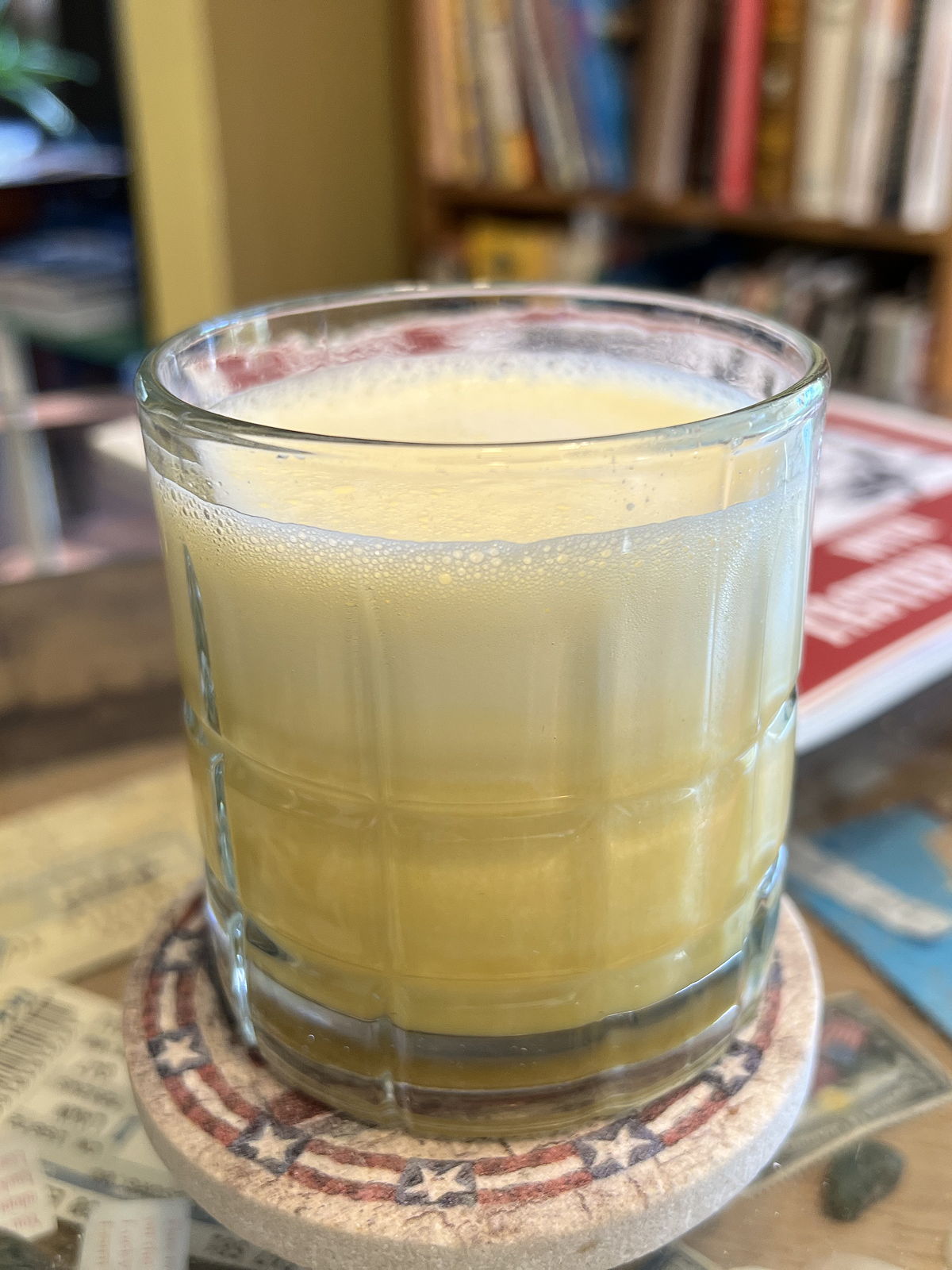
A breakfast eye opener from Eddie Doucette that appeared in newspapers in 1962.
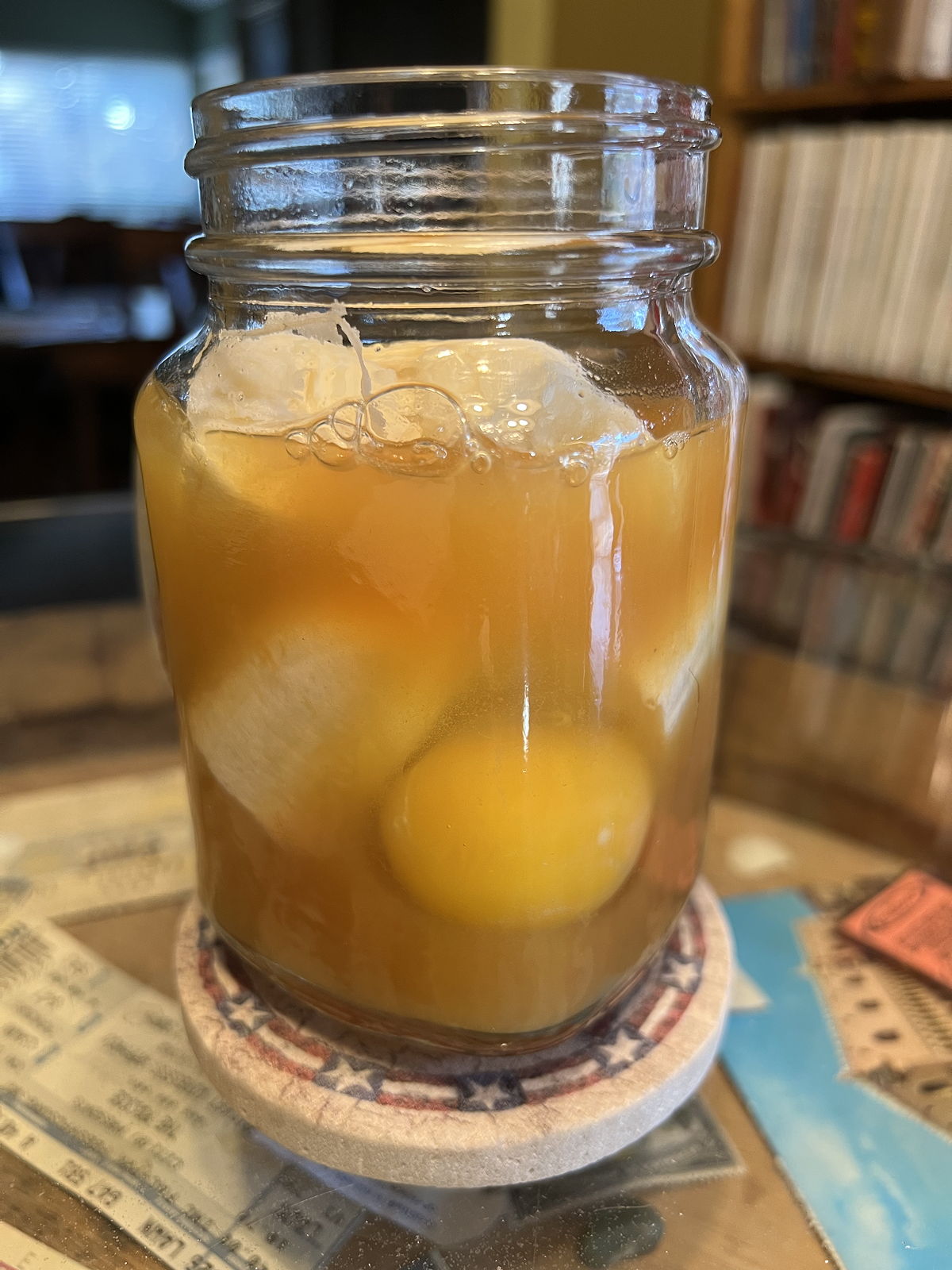
Stephen Martinelli’s 1973 “Instant Breakfast” eschews milk for bananas.
The one variation that doesn’t include milk or cream in my rotation is “Nature’s Instant Breakfast” from Vrest Orton’s The American Cider Book. This explicitly breakfast drink feels and tastes a lot like an eggnog to me. It uses a banana to provide the creaminess necessary for eggnog texture.
While the 1916 recipe has a lot of brandy in it, the eggnog recipes that I use for breakfast don’t. Only one even mentions alcohol, and that’s optional—although it must be said that it’s partly optional because that book came out in 1928, at the height of prohibition. That’s Frigidaire Recipes, and both of the egg-nog recipes from that book say that “This recipe is particularly/very good for invalids.”
Why for invalids? Possibly because eggnogs were considered easy to drink for filling what these old books sometimes called “weak digestions”. But it’s also possible that they made that line up to justify the use of brandy during prohibition. In the recipe’s text, author Verna L. Miller calls the brandy “stimulant”:
Add milk and stimulant and when properly blended serve immediately. Egg white can be beaten separately and folded into the mixture after milk and stimulant are added.… Stimulant can be omitted and a grating of nutmeg can be substituted. This recipe is very good for invalids.
While Frigidaire Recipes has a chapter for “Cocktails”2, their “egg-nogs” aren’t in that chapter. The eggnogs are in their more general “Beverages” chapter.
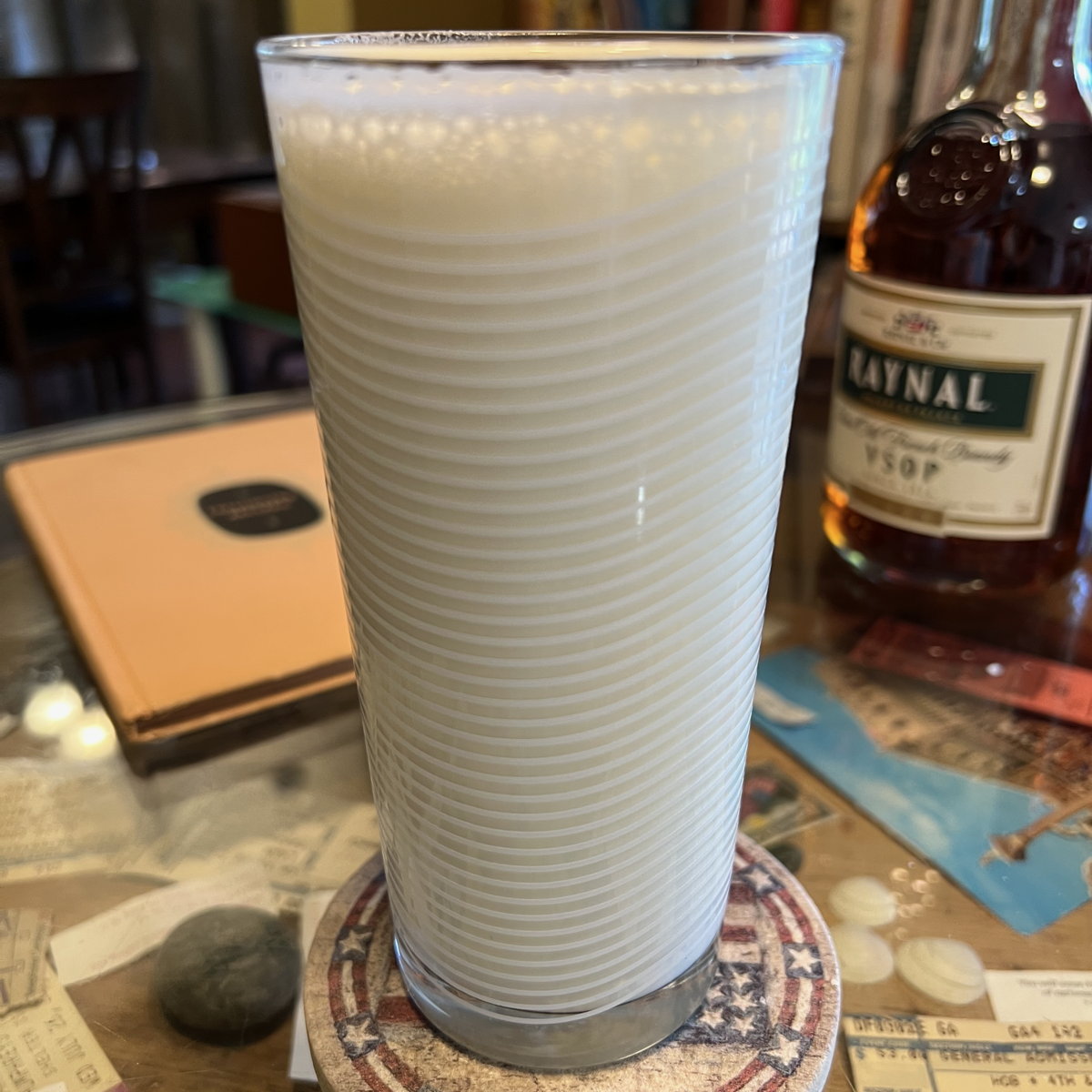
Brandy Egg-Nog
Servings: 1
Preparation Time: 10 minutes
Miss Verna L. Miller
Refrigerator Revolution Revisited: 1928 Frigidaire
Frigidaire Recipes (PDF File, 15.5 MB)
Ingredients
- 1 egg
- speck of salt
- ¾ tbsp sugar
- ¾ cup milk
- 1 tbsp brandy
- nutmeg
Steps
- Egg and milk should be chilled.
- Mix egg, sugar, and salt in a blender.
- Add the milk and brandy; blend until frothy.
- Sprinkle with nutmeg.
- You can also separate the egg(s). Beat the egg white until foamy (not stiff) and fold into the final mixture.
This brandy-flavored eggnog is one of my favorite breakfasts, with or without the brandy—and a tablespoon of brandy in the morning is after all very medicinal. The Frigidaire book also contains a Chocolate Egg-Nog. I’ve never tried it because I rarely have chocolate syrup on hand. I may have to get or make some chocolate syrup just so that I can try a chocolate eggnog.
Should go great with chocolate cake.
There’s an interesting eggnog in Sunkist Recipes for Every Day. While it, also, doesn’t mention breakfast, it looks very much like a breakfast drink to me. There’s a variation for either lemon or for orange.

Lemon Eggnog
Servings: 1
Preparation Time: 15 minutes
Ingredients
- 1 egg, separated
- 2 tbsp lemon juice or ¼ cup orange juice
- 2 tbsp sugar
- milk
- grated lemon or orange rind
Steps
- Beat the egg yolk with the juice and half the sugar.
- Pour into a tall glass.
- Beat egg white very stiff with remaining sugar.
- Fold ¾ of meringue into glass.
- Add milk to almost fill glass.
- Stir well with a spoon.
- Top drink with remainder of meringue.
- Sprinkle grated fruit rind on top.
While this is a nice recipe, I far prefer the others and have not added this to my rotation. On showing the photo of this to a friend, she said “That looks good. And thick.” And it is good, but not thick, and not as good as it looks because of that. The thickness is an illusion. The bulk of the drink is milk with some beaten egg white mixed in. But because the recipe calls for holding back ¼ of the beaten egg white and putting it on top, the nog looks thicker than it really is.
Neat trick, but not what I’m looking for. That said, I drank the whole thing. It’s not that the drink itself is bad, but that it isn’t worth the work to make it.
Eddie Doucette went completely the other way for his specifically-breakfast Orange Nog Breakfast Eye Opener.
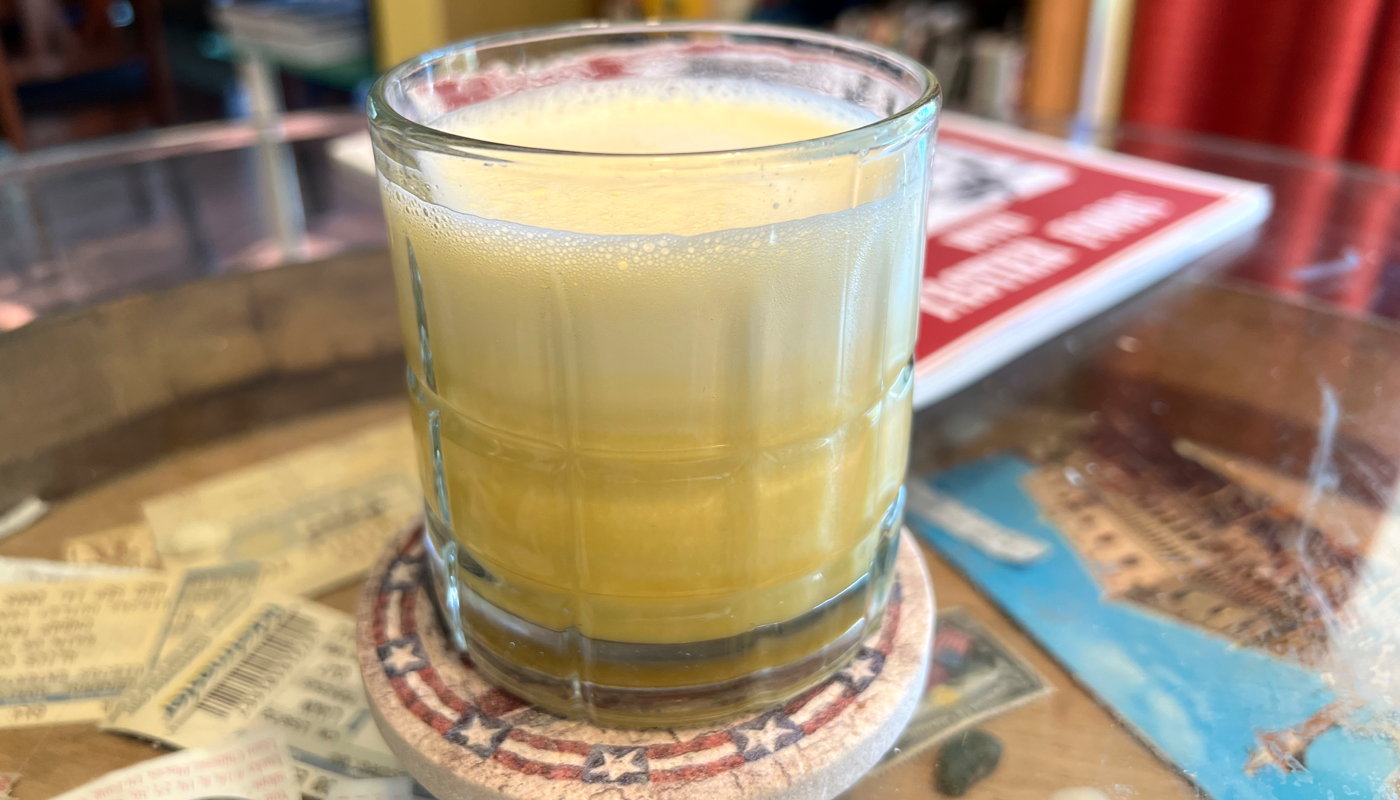
Orange Nog Breakfast Eye Opener
Servings: 3
Preparation Time: 10 minutes
Eddie Doucette
Tempt Them with Tastier Foods: An Eddie Doucette Recipe Collection
Ingredients
- 21 oz orange juice (5 oz concentrate, 16 oz water)
- 4 tsp lemon juice
- 4 tsp honey
- 1 egg
Steps
- Whip together for several seconds until frothy.
- If serving later, pour into three mason-jar cups and whip again before serving.
Doucette’s eggnog doesn’t even try to be creamy. It tries only to be frothy, and it succeeds very well. I wouldn’t be surprised if the use of honey contributes to the frothiness.
My most common breakfast “nog”, however, is Vrest Orton’s Nature’s Instant Breakfast. Like Eddie Doucette’s breakfast, and like many modern versions of older recipes that call for eggs, Orton’s Instant Breakfast doesn’t separate the yolk and the white.3 Separating them is worthwhile if you’re making a large amount for a gathering, but it is more time-consuming than an individual breakfast drink needs to be.

Apple Cider Nog
Servings: 1
Preparation Time: 5 minutes
Stephen Martinelli
The American Cider Book (Internet Archive)
Ingredients
- 1 banana
- 1 egg
- 1 cup or more of chilled apple cider
Steps
- Whip in a blender.
Orton’s recipe is the easiest of all of these, which is part of why I have it the most often of these breakfasts. As you can see in the photo, I make it one serving at a time using a mason jar glass. The top of a mason jar matches the bottom of my blender jar, which means that I can put all of the ingredients in the jar, attach the blade, and blend.
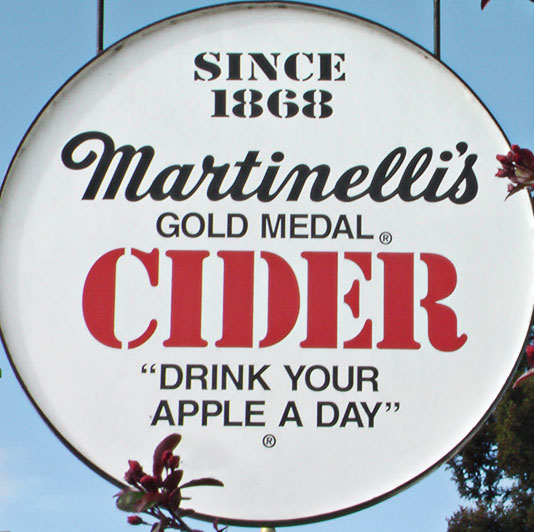
Martinelli’s slogan “Drink Your Apple a Day” applies very well to Stephen Martinelli’s eggnog recipe. I say, Drink Your Breakfast!
If you think that “eggnog” is an odd name, you’re not alone. The origins of the name are lost, but we do know a few things that probably play into it. A nog was a strong ale, and while the origins of the supposed portmanteau “eggnog” are disturbingly unclear, it seems likely that an eggnog has its origins in a posset, or milk with ale (or wine).4 Add an egg to a posset—which we know people did—and it could easily have become an egg nog, which evolved over time into a drink that no longer has any nog in it at all. Neither wine nor ale go into our eggnogs anymore. They’ve diverged into either no alcohol or hard alcohol.
That sadly is pure conjecture on my part. What is not conjecture is that the non-holiday eggnogs of the twentieth century are very tasty.
None of the three 19th century cookbooks I have contain recipes for Egg Nog, or any nog at all. While technically, one of them—The Horsford Cook-Book ca. 1877—is a baking powder book, so is Table and Kitchen.
The reprint of Amelia Simmons’s 1796 American Cookery doesn’t have any “nog” either. It does have syllabubs, which are somewhat similar.
To further speculate well beyond the bounds of reasonable conjecture, it may be that the egg nog did not become respectable enough for community cookbooks or promotional items until alcohol was removed. Certainly, the earliest reference to “egg nog” that Etymology Online provides doesn’t connect it with a respectable person—or a responsible use.
- Arriving, at length at the end of this stage,
- We quitted our cabbin (or rather our cage)
- To the sign of the Anchor we then were directed,
- Where captain O’Keef a fine turkey dissected;
- And Bryan O’Bluster made love to egg-nog,
- And pester’d the ladies to taste of his grog:
- Without it (said Bryan) I never can dine,
- ’Tis better, by far, than your balderdash wine,
- It braces the nerves and it strengthens the brain,
- A world—and no grog—is a prison of pain,
- And Man, the most wretched of all that are found
- To creep in the dust, or to move on the ground!
- It is, of all physic, the best I have seen
- To keep out the cold, and to cut up the spleen—
- Here, madam—miss Cynthia—’tis good—you’ll confess—
- Now taste—and you’ll wish you had been in my mess—
- With grog I’m as great as a king on his throne;
- The worst of all countries is—where there is none,
- New Holland, New Zealand—those islands accurs’d—
- Here’s health to the man that invented it first.
Regardless of where eggnogs came from or how they bifurcated into hard-alcohol drinks and non-alcohol drinks, they’re a great way to have a quick, filling, healthy, and easy breakfast. The worst of all countries is indeed where they have none. Here’s health to whoever made eggnog into an everyday breakfast beverage!
In response to Breakfast lassi: Yogurt and spice is a great way to start the day.
I have a variation on that eggnog, which makes a much smaller batch, at Real frothin’ eggnog.
↑Frigidaire Cocktails also avoids using alcohol. I’d guess that there’s an unwritten assumption that you can add alcohol to most of them if some illegal hootch happens to find its way into your kitchen without your knowledge.
↑For full disclosure, the Frigidaire recipe makes separating the yolk and white an option. I separate. For that recipe, it’s worth the effort.
↑Vrest Orton reproduces a posset ostensibly from revolutionary war general “Lighthorse Harry” Lee in The American Cider Book that looks a lot like a cross between a holiday drink and a pudding.
↑
cookbooks
- The American Cider Book: Vrest Orton at Internet Archive
- “The story of America’s natural beverage.”
- American Cookery: Amelia Simmons at Internet Archive
- “…the art of dressing viands, fish, poultry and vegetables, and the best modes of making pastes, puffs, pies, tarts, puddings, custards and preserves, and all kinds of cakes, from the imperial plumb to plain cake. Adapted to this country, and all grades of life.”
- Refrigerator Revolution Revisited: 1928 Frigidaire
- The 1928 manual and cookbook, Frigidaire Recipes, assumes a lot about then-modern society that could not have been assumed a few decades earlier.
- Review: Ideals Christmas Cookbook Treasury: Jerry Stratton at Jerry@Goodreads
- A collection of three previous Ideals Christmas cookbooks, I found the second and third books most compelling. The recipes are a strange combination of specificity and vagueness, but eggnog and the mince-cheese pie, at least, are excellent.
- The Spice Cookbook•: Avanelle Day and Lillie Stuckey (hardcover)
- “What does cookery mean? It means the knowledge of Medea, and of Circe, and of Calypso, and of Helen, and of Rebekah, and of the Queen of Sheba. It means knowledge of all herbs, and fruits, and balms, and spices, and of all that is healing and sweet in groves, and savory in meat.” If a dish involves any spice at all, this is the first book I look in for a recipe, and I am rarely disappointed. From black pepper cake to saffron rice, this book never fails to provide great ideas and great food.
- Tempt Them with Tastier Foods: An Eddie Doucette Recipe Collection
- When I get locked into a serious recipe collection, the tendency is to take it as far as I can. You can benefit from my obsession with this collection of wonderful recipes from the fifties and sixties “files of Eddie Doucette”, television personality and IGA chef.
food history
- A Centennial Meal for the Sestercentennial
- How did Americans in 1876 celebrate the centennial culinarily? Some of their recipes are surprisingly modern, and some are unique flavors worthy of resurrecting.
- Chocolate Cake For Breakfast: Bill Cosby
- Bill Cosby’s Chocolate Cake for Breakfast, from Himself.
- Etymology of egg-nog at Online Etymology Dictionary
- “also eggnog, ‘sweet, rich, and stimulating cold drink made of eggs, milk, sugar, and spirits,’ c. 1775, American English, from egg (n.) + nog ‘strong ale.’”
- The poems of Philip Freneau, Volume II: Philip Freneau at Internet Archive
- “Poet of the American Revolution.”
- Real frothin’ eggnog
- You are going to need a straw to drink this eggnog—because it’s too frothy to pour out of your glass.
- Review: Table and Kitchen: Jerry Stratton at Jerry@Goodreads
- An entry into the Great Baking Powder Wars, and some fascinating old recipes.
More breakfast
- Breakfast lassi
- Yogurt and spice is a great way to start the day.
- Granola, the ultimate breakfast
- Granola tends to be the more expensive cereal in stores, but the easiest and cheapest to make at home.
- The Big Kitchen
- Review of Golden Hill’s cultural center, with Judy the Beauty on Duty, The Big Kitchen. Breakfast and Lunch seven days a week

